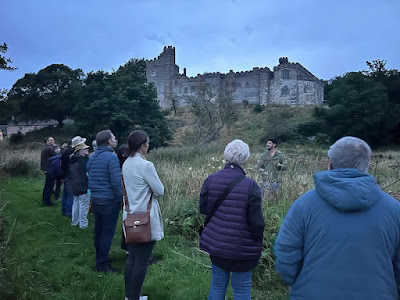Claire Moran, a new Communications Officer at the Bat Conservation Trust, went to a bat watch at Haddon Hall, one of England's oldest houses. Organised by Steve Roe and the Derbyshire Bat Conservation Group, attendees got to spend time with hundreds of bats in an ancient chapel and walk along the River Wye using bat detectors and thermal cameras. In this blog she tells us what she saw.
Bats in the Hall
Hundreds of bats fly about a stained-glass window aglow with sunset. It’s an enchanting spectacle, and even the shower cap I'm given to protect my hair from bat wee doesn't make it any less magical.
I'm at Haddon Hall’s first bat watch event, where myself and a handful of people, are treated to a sight unfortunately rare in the UK: lots of bats. Certainly, I’ve never seen so many bats. In fact I don’t think I’ve even seen this many mammals together in real life that aren’t sheep or humans.
Our watch starts in the chapel which is very old, parts of it date to the 12th century. I’m no historian, but you can feel the age in its rough walls, which are covered in colourful drawings of leaves and flowers, religious scenes and strange symbols. Bats take advantage of the craggy walls, clinging onto them briefly before dropping down into flight.
 |
| Bats cling to the ancient walls of the chapel of Haddon Hall. |
When we enter the chapel at around 8pm, the number of bats flying above us is already impressive. As is their smell, sweet, musky and somehow familiar, mammalian – and their chattering squeaks. More bats join the swirls above our heads every minute.
Derbyshire Bat Conservation Group
Steve Roe from Derbyshire Bat Conservation Group (also BCT trustee and creator of our award-winning podcast) leads the night. Steve tells us the chapel’s bats are a maternity roost of common and soprano pipistrelles. Some are youngsters, just weened.
 |
| Bats in the chapel at Haddon Hall. Steve Roe (BCT trustee and podcaster, Derbyshire Bat Conservation Group) talks. |
A great storyteller, Steve conjures up the world of bats, its wonder and vulnerability. And he sprinkles in some amazing facts, in one instance by literally sprinkling bat poo to show us how it glitters.
At the end of his talk, the lights are turned off, the doors closed, and somehow even more bats take to the wing. Now they’re swooping to their exit point, a crack above the church door. A thermal camera shows us what the shadows conceal, as the bats consider leaving, think better of it, wheel away, and return.
History at Haddon Hall
Haddon Hall is one of the oldest houses in the UK. Uniquely, it was left unoccupied for 200 years and so has not been subject to the sort of renovations other grand houses have undergone.
Approaching it through the Peak District you feel like you’re going back in time, as A-roads turn into country roads lined with stone walls or old hedgerows. Once on the grounds, the hall oozes character: part Lord of the Rings, part Dracula’s castle (in fact some famous fantasy films have been shot here, including The Princess Bride).
Haddon Hall is not as well-known as great houses like Chatsworth, or rewilding projects like Knepp, but it deserves to be. It has 187 hectares of parkland, woodland, river, water meadows, wetlands and former farmland. All sorts of mammals, insects, plants and fungi live here, and several species of bat forage, commute or roost on Haddon land. The Hall itself is a bat roost, and they often find bats behind tapestries.
Bat detectors on the Wye River
With the sun about to disappear, we’re given bat detectors and led to the Wye, a river which winds through Haddon Hall’s ancient parkland. Clouds of white moths flutter up from the wild flowers and grasses, food for the bats. The air is sweet summer air full of pollen and warm earthy tones, fresh after the musk of the chapel.
In the dark the river looks spectral, it’s glassy surface full of shadows. Have I even seen a river at night before? I’m not sure I have. Holding my detector, I feel like a Ghostbuster. Alien sounds, clicks and clacks, faster and louder, announce bat after bat.
Steve tells us that noctules and Daubenton’s bats are flying over the water. I can see that some of these are bigger, and they move differently from the chapel’s bats snaking about above the water.
We stand awhile on a narrow stone bridge, which looks like goblins made it. It starts to rain, but it doesn’t dampen the wonder, as we use a thermal camera and see bats, otherwise invisible, among the trees lining the river.
After this our bat watch is over, and squinting our dark-adapted eyes, we make our way out of this enchanting place to go home.
Spectacle and conservation
It was both exhilarating and sobering to see so many bats at Haddon Hall. I was lucky to see such a spectacle, and it made me mad I was so lucky. Humans have so devastatingly quickly created a world where most people don’t know what a few hundred bats look like.
Aside from ethical and practical problems stemming from and causing the biodiversity crisis, I think it makes us lonely to be without our fellow species. But places like Haddon act like beacons, they remind us that it wasn’t always this way, that enchantment used to be part of life, and there is lots we can do to bring the magic back.








No comments:
Post a Comment